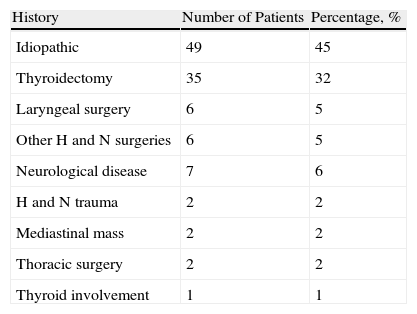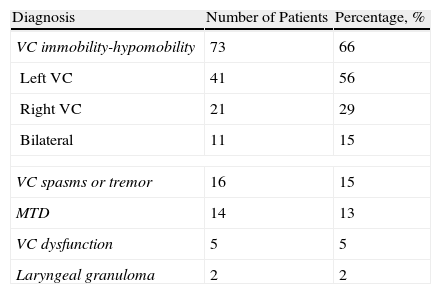Laryngeal electromyography, together with clinical evaluation, is a valuable tool for voice disorder management. It assesses the integrity of laryngeal nerves and muscles, contributing to the diagnosis of many diseases, especially laryngeal movement disorders. Our purpose was to describe the experience of the first Spanish series with laryngeal electromyography in evaluating voice disorders.
MethodsA prospective study was designed to evaluate laryngeal movement disorders with laryngeal electromyography. Both the cricothyroid and thyroarytenoid muscles were tested routinely and, in some cases, the posterior cricoarytenoid muscle. The laryngeal electromyography technique and result interpretation were performed by a laryngologist and a neurophysiologist.
ResultsWe included 110 patients, with the most common symptom being dysphonia. Laryngeal electromyography was performed in 85% of cases. Primary diagnosis before electromyography was laryngeal immobility. Positive predictive value for diagnosis in cases of paralysis was 88%.
ConclusionsLaryngeal electromyography is a useful adjunct, together with clinical evaluation, for diagnosis and management of motion abnormalities in the larynx in patients who present with dysphonia.
La electromiografía laríngea es una herramienta útil en el diagnóstico y tratamiento de los trastornos de la voz. Proporciona información acerca del estado de los nervios y músculos laríngeos completando la evaluación diagnóstica de un gran número de afecciones, fundamentalmente los trastornos del movimiento laríngeo. Presentamos la primera serie española, hasta donde tenemos referencias, que describe la utilidad de dicha prueba en la valoración de los trastornos de la voz.
MétodosSe diseñó un estudio prospectivo descriptivo mediante la creación de un protocolo de valoración para trastornos del movimiento laríngeo, que incluyera la realización de electromiografía laríngea. Los músculos estudiados fueron ambos cricoaritenoideos y tiroaritenoideos en todos los casos y el cricotiroideo posterior en algunos pacientes. La realización de la prueba y la interpretación de los resultados se realizó de forma conjunta por un especialista en Otorrinolaringología y un especialista en Neurofisiología Clínica.
ResultadosCiento diez pacientes fueron incluidos en el estudio. El síntoma de presentación más frecuente fue la disfonía. Se realizó electromiografía laríngea en un 85% de los casos. La entidad diagnóstica más frecuente fue la inmovilidad laríngea. En el caso de la parálisis laríngea, la electromiografía tuvo un valour predictivo positivo del 88% para el diagnóstico.
ConclusionesLa electromiografía laríngea es una herramienta útil utilizada de forma conjunta con la exploración clínica en el diagnóstico y el tratamiento de las alteraciones del movimiento laríngeo que cursan habitualmente con disfonía.







